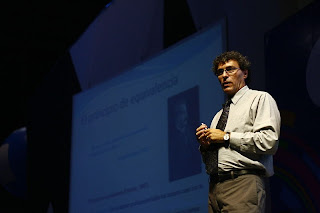'Warp drive' could be real. In fact, NASA is working on it!
Fans of sci-fi TV tend to be sharply divided between "Star Trek" fans and "Babylon 5" fans. To be sure, three is a great deal of overlap. But partisans of the two shows often divide quite sharply. Dr. Sheldon Cooper of "The Big Bang Theory" is an example of an extreme "Star Trek" partisan- which is strange, because one of the reasons why I fall into the other camp is that the science of the B5 universe seems to me, on the whole, to be a great deal more realistic, even down to things like rotating crew compartments on space ships in order to create artificial gravity. In one episode of TBBT, even Sheldon, in fact, shared his shattering realization that if something like the transporter were actually built, it wouldn't actually transport a person from Point A to Point B. It would kill him- annihilate him physically- and then assemble an exact copy of him somewhere else. The copy would have the same memories as the original, and might be similar in all respects. But it would not be him.
Like Dr. Cooper, I, for one, would not willingly make use of a transporter!
Another thing that irritates me about "Star Trek" is it's built-in, Gene Roddenberry-inspired and wholly unrealistic optimism about the future. Human nature doesn't change over time. We may indeed have cured cancer in the 23rd Century (though the common cold, according to the franchise chronology, won't be cured until somewhere between the original series and "The Next Generation'!" But prejudice, aggression, and the other negative aspects of human behavior will not have gone away. Score one for B5- a future in which humans (and even Mimbari) are still human (or Mimbari)!
But there is one respect in which "Star Trek" does score: warp drive. Since the theoretical basis for Einstein-Rosen bridges (aka "wormholes") between two incredibly distant points in space has been established for a very long time (they may very well exist in nature, although the math indicates that they would dissipate pretty much as soon as they came into being), I've always thought of methods of getting around the necessity of faster-than-light travel for voyages for all but the closest stars, given the immense distances involved, such as B5's "jump gates" or "Stargate's" stargates- essentially artificially induced, stable wormholes- were more realistic than a warp drive (an artificially created bubble or pocket universe of distorted space which could travel faster than light- relativity places no speed restrictions on space- inside of which a ship would remain stationary relative to the bubble but be taken along on the bubble's faster-than light drive), Even sounds implausible, doesn't it?
Except as it turns out, it's not. A Mexican physicist named Miguel Alcubierre Maya was intrigued by the idea, and worked out a theory of how a warp drive might actually work. I'm currently reading a sci-fi series- Star Carrier, by Ian Douglas- in which interstellar travel is achieved precisely through "Alcubierre drive" (starships are powered in these books by a gravitic drive consisting of artificial singularities- in essence really, really tiny black holes- projected in the direction the ship wants to go, winking in and out of existence thousands of times per second).
There are practical problems, as might be expected (the Wikipedia article on Alcubierre Drive linked to above discusses them). But they may not be insurmountable. In fact, NASA is working on the possibility of some day constructing a real, working Alcubierre drive to power starships of the future!
Alcubierre says quite openly that he was inspired by "Star Trek." So as naïve as Gene Roddenberry might have been about human nature, and as ridiculous as some of his science fictional devices might be, you have to give the guy credit: he came up with the theory of Alcubierre drive before even Alcubierre thought of it.
Photo of Dr. Miguel Alcubierre by Campus Party Mexico



Comments